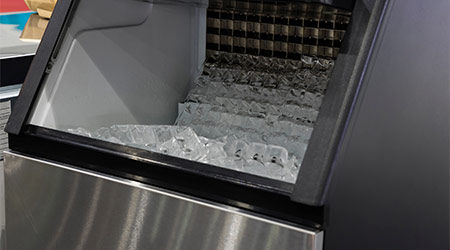Ice machines are not an environment where viruses, like COVID-19, can grow because a virus requires a living cell in order to reproduce. While it is possible to transfer coronavirus to a patient by someone using an ice machine, there are ways to ensure that this doesn’t happen.
According to David Covell, Health Commissioner for Lorain County, Ohio and President of the Association of Ohio Health Commissioners, "As is with most of the diseases that might be associated with an ice machine, mostly the danger is someone dishing that ice out with their hand."
Here’s what you need to know to reduce the chances of contamination and spreading the disease when serving ice to patients.
How is coronavirus spread?
Coronavirus (or COVID-19) is a contagious disease that transmits from person-to-person. The virus is transmitted through airborne respiratory droplets from an infected person through sneezes or coughs.
Many of the CDC guidelines for reducing the spread of infectious diseases are just as effective for coronavirus as other more known pathogens.
Training staff on enhanced hygiene measures
The CDC has some specific best practices that have been suggested for years to help stop the spread of infectious diseases. These practices are just as effective against coronavirus. They are:
• No handshakes or hugs – use other methods of greeting to avoid contact
• Clean hands at the door and schedule regular hand washing reminders by email or text
• Create habits and reminders to avoid touching their faces and cover coughs and sneezes
• Disinfect surfaces like doorknobs, tables, desks, and handrails regularly
• Increase ventilation by opening windows or adjusting the air conditioning
When washing hands, employees should spend at least 20 seconds washing with soap and water. They should always wash their hands after using restroom facilities, caring for patients, or touching their face.
Hospital staff that exhibit symptoms should stay home
Coronavirus symptoms include fever, cough, and shortness of breath. If you see any healthcare staff exhibiting these symptoms, send them home.
This can be difficult to ascertain since many of the known cases of coronavirus exhibit mild enough symptoms that are easy to hide.
For this reason, hospital staff should pay attention to even the mildest symptoms. Maintain an open work environment where your staff feels safe talking about potential symptoms and can stay home to recuperate.
Follow proper ice handling practices
Many ice machines come with a bin, where staff must scoop the ice out to serve to patients. These machines run the risk of contaminating the ice supply if an infected individual happens to touch the ice with their hand.
While viruses like the coronaviruses won’t grow on an ice cube, according to the World Health Organization, there is no reason to believe ice kills the virus.
When using an ice machine with a bin, there are a few tips staff should follow to prevent spreading of disease:
• Always keep the bin door closed when ice is not being used.
• Require employees to wash their hands before scooping ice out of the bin.
• Always use an ice scoop to dispense ice. Do not scoop using glassware.
• Store the ice scoop outside of the bin.
• Regularly clean and rinse the scoop with a mixture of 8 oz of chlorine bleach per gallon of water.
To sanitize the ice scoop, spray with a mixture of 2 tsp chlorine bleach per gallon of water (you can also sanitize the scoop in a commercial dishwasher if available).
Ice dispensers are very popular in healthcare facilities because they dispense ice directly into glassware, rather than scooping it out by hand. It’s a far more hygienic delivery system, but it’s not free from potential contamination.
Many dispensers require users to press a button to dispense the ice. If an infected individual coughs or sneezes into their hand and touches this button, they can transfer the virus to the button, which could be picked up by the next user. It can be challenging to consistently keep this area sanitized.
“Is it really realistic for someone to be sanitizing or cleaning [the area] every time a person uses it?” asked Covell, “We have a big saying here in our mission statement, we want to make the healthy choice the easy choice.”
Staff using the machine should make a conscious effort to disinfect these areas. Place a supply of disinfecting wipes or hand sanitizing stations near the machine. Instruct staff to disinfect the area after every use. Making it easy for employees to practice proper ice handling techniques helps to decrease the chances of accidental contamination.
Disinfect and sanitize ice equipment
Disinfecting and sanitizing ice equipment can also help to reduce the possibility of contamination. There are many approved cleaners the EPA suggests using to combat viral contaminants. Bleach is the most widely used and cost-effect disinfectant on the market.
Ice machines should be disinfected with a bleach concentration approved by the CDC to kill viral pathogens. Make sure to rinse after cleaning.
Sanitizing requires using a lower concentration. Allow the mixture to air dry to sanitize the machine thoroughly.
Cleaning the exterior of your equipment
• Pre-wash any soiled area with warm water
• Wipe the area with a solution of 8 oz of bleach per gallon of water (or other EPA approved cleaner)
• Let the solution sit for at least 5 minutes
• Rinse the area thoroughly with water and let air dry
• To sanitize further, spray the area with a mixture of 2 teaspoons of bleach to one gallon of water
• Let air dry
Cleaning the inside of your ice bin
• Use a spray bottle to saturate the contaminated surfaces
• Wipe the areas to remove the debris and make sure to rinse the area well
• Once you’ve wiped the bin down after disinfecting, reapply the solution to sanitize
• Leave the mixture to air dry
Make sure you also clean your ice machine’s air filter regularly to help decrease the growth of biofilms within the machine.
Keeping patients safe starts with your staff
It’s the responsibility of all staff to work in a manner that is consistent with reducing the chances of hospital-acquired infections. Protection starts with your staff. Following proper ice handling procedures is one more way to stop the spread of infectious diseases like COVID-19. Maintaining a clean work environment will also reduce the risk of accidental contamination.
John Mahlmeister is the Chief Operating Officer and Co-Founder of Easy Ice. For more information, please visit www.easyice.com.

 UF Health Hospitals Rely on Green Globes to Realize Their Full Potential
UF Health Hospitals Rely on Green Globes to Realize Their Full Potential How Healthcare Facilities Can Be Truly Disaster-Resilient
How Healthcare Facilities Can Be Truly Disaster-Resilient TriasMD Breaks Ground on DISC Surgery Center for San Fernando Valley
TriasMD Breaks Ground on DISC Surgery Center for San Fernando Valley Bigfork Valley Hospital Falls Victim to Data Breach
Bigfork Valley Hospital Falls Victim to Data Breach AI-Driven Facilities: Strategic Planning and Cost Management
AI-Driven Facilities: Strategic Planning and Cost Management